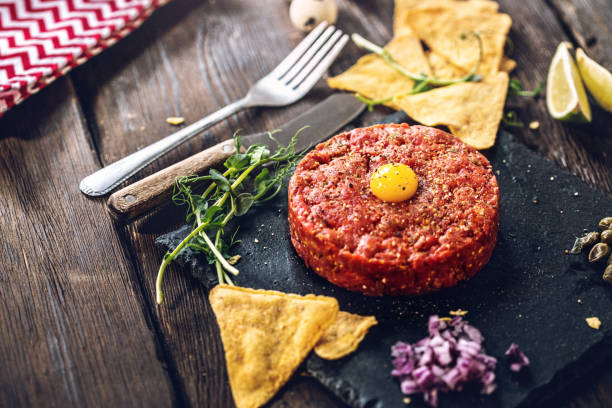Steak tartare is believed to have originated in Europe, particularly France, and it has variations worldwide, such as the Ethiopian kitfo or the Korean yukhoe. The basic components of traditional steak tartare include:
- High-Quality Beef: The key to safe steak tartare is using the freshest, high-quality beef. It’s typically made from tender cuts like filet mignon and is meticulously trimmed to remove any fat, sinew, or connective tissue.
- Aromatics: Flavorful ingredients like shallots, capers, and fresh herbs enhance the taste and aroma of the dish.
- Seasonings: Common seasonings include Dijon mustard, Worcestershire sauce, and freshly ground black pepper.
- Egg Yolk: An egg yolk is often added to the mixture for a creamy, luscious texture.
- Condiments: Cornichons, anchovies, and sometimes Tabasco or cognac contribute to the depth of flavor.
The Rewards of Steak Tartare
- Flavor Explosion: Steak tartare offers a unique and intense beefy flavor that is unlike any other preparation. The raw meat showcases its natural taste without the influence of cooking.
- Texture and Temperature: The tender, silky texture of raw beef, often finely minced, combined with the creaminess of the egg yolk creates a delightful contrast. Moreover, it’s typically served chilled, providing a refreshing sensation.
- Culinary Experience: For adventurous food enthusiasts, consuming steak tartare is a culinary adventure, offering the thrill of trying something unconventional and savoring a delicacy enjoyed by many.
Addressing Safety Concerns of Steak Tartare
Now, let’s tackle the primary concern: the safety of consuming raw meat. There are legitimate reasons to approach steak tartare with caution:
- Bacterial Contamination: Raw meat, especially when ground, can be susceptible to bacterial contamination, notably from E. coli, Salmonella, and Listeria. Such contamination can lead to foodborne illnesses.
- Cross-Contamination: The preparation of steak tartare requires meticulous attention to hygiene. Cross-contamination from cutting boards, knives, or other surfaces that have been in contact with raw meat can pose a risk.
- Sourcing Quality Meat: The safety of steak tartare largely depends on the quality of the beef. Using subpar or aged meat increases the risk of consuming harmful bacteria.
- Underlying Health Conditions: People with compromised immune systems, pregnant individuals, and the elderly are more vulnerable to foodborne illnesses and should avoid raw or undercooked meat.
Safety Measures for Enjoying Steak Tartare
If you’re determined to enjoy steak tartare, follow these safety guidelines:
- Quality Meat: Choose high-quality beef from reputable sources, ensuring it’s fresh and free from visible imperfections.
- Meticulous Preparation: Pay attention to hygiene during the preparation process. Keep all utensils and surfaces clean and sanitized.
- Minimize Cross-Contamination: Use separate cutting boards and knives for the raw meat, and wash your hands thoroughly after handling it.
- Serve Fresh: Consume the dish as soon as it’s prepared. Don’t let it sit at room temperature for an extended period.
- Consume Responsibly: If you have underlying health conditions or are in a high-risk group, it’s advisable to avoid raw meat altogether.
The Verdict on Steak Tartare
The question of whether steak tartare is safe to eat has a nuanced answer. When prepared with fresh, high-quality beef and meticulous attention to hygiene, steak tartare can be enjoyed with minimized risk. It offers a unique culinary experience, showcasing the pure, unaltered taste of the meat. However, if you have concerns about bacterial contamination, you should exercise caution or explore alternative dishes that satisfy your culinary curiosity without the need for consuming raw meat.
